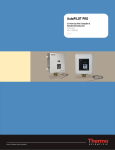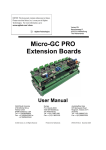Download Model HR-3P Projector Controller
Transcript
Hall Research Technologies, Inc Phone: Fax: 1163 Warner Ave. Tustin, CA 92780 (714) 641-6607 (714) 641-6698 Operation Instructions Advanced Projector Controller And Video Splitter • Composite, VGA, and S-Video inputs • Composite, S-Video, and 2 VGA outputs • Discrete (Digital) Input and Output • Programmable RS-232 Port UMA 1026 REV B Projector Controller w/ Built-n VGA Splitter Table of Contents Description .....................................................................3 Features.........................................................................3 How To Obtain the Windows® Programming Software .........3 Setup to Program HR-3P ..................................................3 Setup to Use HR-3P.........................................................4 Operation.......................................................................4 How To Use The HR-3P ....................................................5 Selecting the Baud Rate ...................................................5 Selecting the Scan Priority................................................6 Selecting a delay for the No Input Active string...................6 Selecting a string for each of the 7 events..........................7 How to Build a String with the HR-3P Programmer ..............8 Uploading to the HR-3P....................................................9 Loading or Saving Configurations ......................................9 Putting the HR-3P into Operation.......................................9 Important!............................................................................................................................................................................................9 Federal Communications Commission Statement .............. 11 Warranty...................................................................... 11 Limited Liability............................................................. 11 2 Projector Controller w/ Built-n VGA Splitter Description The Model HR-3P is a programmable serial device with 3 video inputs VGA, Composite Video (CV) and S-Video (Y/C). The VGA input supports all PC resolutions to 1600x1200 and the TV video inputs are NTSC, PAL, and SECAM compliant. The unit has a VGA splitter with 2 VGA outputs, but the CV and S-Video have only one output each (pass through). The HR-3P can detect video on any of the inputs and issue preprogrammed serial commands via its RS-232 port. It also features 1 discrete (digital or contact closure) input and 1 discrete output. The discrete input can be used to issue commands on its high-to-low, and low-to-high transitions. The unit also keeps track of ON/OFF state of the projector and outputs a TTL (hi/lo digital) signal on its discrete output line for controlling other external devices such as lowering and raising a screen. The HR-3P is an ideal tool for the automation of a projector. The commands sent to the projector can be any ASCII (or non-ASCII) data with programmable delays embedded in the string. Hall Research Technologies, Inc. provides a powerful Windows™ based application that is used to create the data files and upload it to the HR-3P. Features 1. Compact, Rugged, Reliable, and Economical 2. High Resolution VGA Distribution amp can drive cables to 150 feet on outputs 3. Wide bandwidth supports resolutions to 1600x1200 at any refresh rate 4. Up to 8 user-programmable Command Strings 5. Allows multiple instances of user-defined delays within each string 6. Detects video on any input , or no video at all 7. Digital (discrete) input and output on screw terminals 8. Intuitive Operation 9. Comes with Windows™ software for programming 10. Made in USA How to Obtain the Windows® Programming Software The GUI (Graphical User Interface) needed to program the HR-1P can be downloaded at: http://www.hallresearch.com/page/Products/HR-3P Setup to Program HR-3P 1. Connect the provided power supply to the power port on the back right side of the device. 2. Connect a crossover serial cable (provided) from a PC to the HR-3P. 3. Install the HR-3P Programmer software on the PC. 3 Projector Controller w/ Built-n VGA Splitter Setup to Use HR-3P 1. Connect the provided power supply to the power port on the back right side of the device. 2. Attach any VGA, Composite, and/or S-Video signals as necessary to the appropriate input jacks on the back of the device. 3. Connect the output from the video signals to appropriate video display devices. 4. Connect the discrete inputs to an appropriate switch. Connect the discrete output to a relay. These discrete inputs/outputs are not required for the HR-3P to have some functionality, but usually you will want to use at least one of them. These discrete input and output are intended to operate using the power from the HR3P. Do not supply any power to the discrete input/outputs. You simply need to open or close the circuit between a discrete and the ground connection provided on the discrete input/output terminal. 5. Connect the HR-3P to the projector via a crossover serial cable or a straight through serial cable depending on the projectors pinout. Operation The HR-3P is designed to send a string of commands that you create to a projector or other device via a serial interface anytime 1 of 7 events occurs. The following is a list of each event and the conditions necessary to facilitate each event: 1. When any video is first detected, the discrete output will be pulled low and the Video First Detected string will be sent out the serial port. 2. When Discrete Input transitions from a high to a low signal, the HR-3P will send the Discrete OFF string out the serial port. 3. When Discrete Input transitions from a low to a high signal, the HR-3P will send the Discrete ON string out the serial port. 4. When the VGA video input is selected, the HR-3P will send the VGA Input Active string out the serial port. 5. When the Composite video input is selected, the HR-3P will send the Composite Input Active string out the serial port. 6. When the S-Video input is selected, the HR-3P will send the S-Video Input Active string out the serial port. 7. When no video inputs are active, the HR-3P will send the No Input Active string out the serial port and set the discrete output high. Each of these 7 strings can have a maximum of 30 characters and minimum of 0 characters. Within each string wait times can be inserted. Each wait can be a maximum wait time of 16 hrs, 59 min, 59 sec. Each wait takes 3 characters so a maximum of 8 waits is possible per string. (3 characters x 8 waits = 24 characters) Non-printing control characters may also be inserted into the strings. The following is a list of the possible control characters and their corresponding hexadecimal values. 4 Projector Controller w/ Built-n VGA Splitter CHAR NULL SOH STX ETX EOT ENQ ACK HEX 0x00 0x01 0x02 0x03 0x04 0x05 0x06 CHAR BEL BS HT LF VT FF CR HEX 0x07 0x08 0x09 0x0A 0x0B 0x0C 0x0D CHAR SO SI DLE DC1 DC2 DC3 DC4 HEX 0x0E 0x0F 0x10 0x11 0x12 0x13 0x14 CHAR NAK SYN ETB CAN EM SUB ESC HEX 0x15 0x16 0x17 0x18 0x19 0x1A 0x1B CHAR FS GS RS US HEX 0x1C 0x1D 0x1E 0x1F These strings can either be constructed directly in the HR-3P Programmer or by using a hex editor to create a file containing the desired string. The projector will communicate with the HR-3P at the baud rate specified in the user’s manual of the projector. The HR-3P Programmer will allow the user to select that baud rate for the projector. The HR-3P will also allow the user to select which video input if any has priority over the others. The user also has the ability to delay the No Input Active string before it is sent out the serial port. You will need to consult the manual or the manufacturer’s data for how to construct the correct string for various functions of the projector. Since each manufacturer uses there own set of commands, Hall Research Technologies, Inc. cannot help in obtaining this information for you. How to Use the HR-3P The first step to programming the HR-3P with the HR-3P Programmer is to connect the HR-3P to the computer that is running the HR-3P Programmer via the COM port you will select when you start the HR-3P Programmer software. The com. ports the HR-3P Programmer supports are COM1 thru COM5. After selecting a COM port, you will need to decide if you want to edit an existing configuration file or create a new configuration file. A configuration file is all the information that will be uploaded to the HR-3P. It consists of the baud rate, the video priority, the delay of the No Input Active string and the 8 different strings. Configuration files will have the file extension of “.hrt”. Selecting the Baud Rate Select the baud rate from the drop down menu labeled Projector Baud Rate. This is the baud rate that your projector is set to for sending and receiving serial commands. This will be found in your user’s manual for the projector or from the projector’s manufacturer. 5 Projector Controller w/ Built-n VGA Splitter Selecting the Scan Priority The scan priority exists to give one video input priority over the other two. You may also choose to give none of the video inputs priority. The way the HR-3P selects a video input is by cycling through each video input. It will cycle in the order of VGA, S-Video, Composite, and then it will start again with VGA and continue to scan. As soon as a signal is detected on any of the inputs, that video input is selected. After an input is selected, no other input will be selected until that original video input is unplugged or turned off or the video input with priority is turned on. If for example S-Video had priority and no video inputs were selected then the HR-3P would just cycle through each input looking for a signal. If the first signal it finds is Composite then it would select composite and send the Composite Input Active string out the serial port. If it then found the VGA signal to be active, it would not select the VGA input since the VGA input does not have priority. If the Composite input were to be unplugged then the HR-3P would select the next active signal in order of scanning. In this case it would select VGA since VGA is the next signal in the scanning cycle that is active. If S-Video were to become active later while VGA was selected, S-Video would then become selected over VGA since S-Video has priority. Only 1 video input may have priority at any given time. By default, scan priority is given to none. Selecting a delay for the No Input Active string By default, the No Input Active string is sent out through the serial port as soon as there are no active inputs to select from, i.e.: there is no video signal at any of the three input connectors. If you want to delay the No Input Active string then you simply fill in the fields for the amount of wait you want to add. If, for example, you wanted to send out the No Input Active string 1 hour, 15 minutes and 30 seconds after the HR-3P had detected no active signals then you would enter a 1, 15 and 30 in the respective fields. Typical commands to send in this situation might be to have the projector enter standby mode or to turn it off. 6 Projector Controller w/ Built-n VGA Splitter Selecting a string for each of the 7 events To specify a string for any of the 7 events, first select the string you want to specify from the drop down menu labeled, Select a String. After you have selected the string you want to work with you then need to choose how you will input that string. You have two options for inputting the string. You may create the string in a third-party hexadecimal editor and then save that file with a “.str” extension and then click the “Select File” button to select the file you created. Or you can build the string directly in the hexadecimal editor built into the HR-3P Programmer by clicking on Build String. If you choose “Select File” only the name of the file containing the string will be displayed in the window directly above the “Select File” button. If you choose to build the string then the actual characters in the string will be displayed in the window above the “Build String” button. 7 Projector Controller w/ Built-n VGA Splitter How to Build a String with the HR-3P Programmer To build your own string using the HR-3P Programmer, click on the “Build String” button. To enter any characters from the keyboard, simply click in the window labeled “Enter Codes for <name of string>” and begin typing. If you need to enter any of the non-printing control characters, select them from the “Control Characters” menu and click the “Insert Control Character” button and that character will be inserted into the string. If you want to insert a wait in the string, fill in the appropriate time fields and click the “Insert Wait Time” button. When you have finished building the string, click the “Done” button and you will see the string you just built in the main HR-3P Programmer screen. Here is an example of a string with several characters entered from the keyboard, then a wait time, then a control character, and then some more characters from the keyboard. 8 Projector Controller w/ Built-n VGA Splitter There are a few restrictions you need to be aware of when you are building your string. You may not backspace or delete as you are building the string. Doing so will delete the entire string you have constructed. You may not use the Windows “Paste” function to insert more than one character at a time. Doing so will result in the string being deleted. You may only insert a character at the end of the string. If you attempt to enter a string over 25 characters, your string will be deleted. This can be avoided by watching the “File length:” indicator at the bottom of the screen. Any character input from the keyboard will increment the File length by 1, same for a Control Character. A wait time will increment the File length by 3. Uploading to the HR-3P After you have selected a baud rate, priority, No Input Active string delay, and strings for each of the 7 strings, you can then click the “Save and Upload” button and this configuration will be saved to the configuration file you created or opened at the start and this configuration will be uploaded to the HR-3P. If you leave any of the strings blank then a 0 length string will be used meaning nothing will be sent out the serial port for that event. If you do not specify a delay for the No Input Active string then there will be no delay before that string is sent out the serial port. The upload procedure should take 4-7 seconds. When it is finished you will see a message indicating the success or failure of the upload procedure. Loading or Saving Configurations You can save or load a configuration file by clicking on the File menu and choosing the appropriate icon. You can also create a blank, new configuration file from the File menu. Putting the HR-3P into Operation After you have successfully uploaded a configuration to the HR-3P, disconnect the HR-3P from the computer and power it off. Connect the HR-3P to the projector via the serial interface. Important! You may need to use a straight through serial cable (also know as a NULL-modem cable) (not included) to connect the HR-3P to the device you want to control. There are 2 types of serial devices: 1. DTE (Data Terminal Equipment) ex. Computer/ PC , HR-3P 2. DCE (Data Communication Equipment) e.g. Serial controlled projector, modem 9 Projector Controller w/ Built-n VGA Splitter DTEs talk directly to DCEs. If you have 2 DTEs trying to talk, they need a crossover serial cable connecting them. In the same way if you have 2 DCEs trying to talk, they will need a crossover serial cable connecting them as well. Generally DTEs will have a male DB9 connector and DCEs will have a female DB9 connector. You will notice that the serial cable included with the HR-3P has a female DB9 connector on both ends. This is a crossover serial cable. This cable is required to connect the HR-3P to the PC to upload the strings. Because the HR-3P has a Male DB0 connector, this indicates that the HR-3P is a DTE, which is why it requires a crossover serial cable to connect to a computer/PC serial port. When you are done uploading the strings to the HR-3P, you will need to use a crossover or straight through serial cable to connect the HR-3P to your serial device depending on what type of serial device you are trying to control. Here is the pinout of the HR-3P. The pinout of the DB9 male connector on the HR-3P is as follows: Pin 1 2 3 4 5 Function Not Used Receive (input) Transmit (output) DTR (output, pulled high) Ground Pin 6 7 8 9 Function Not Used RTS (output, pulled high) Not Used Not Used Connect the discrete input and output to the appropriate switches; connect the necessary video inputs and outputs to the correct ports on the HR-3P and power on the HR-3P. The HR-3P is now scanning for active video signals and change in the discrete input. NOTE The discrete I/O is not designed to source or sink much current. The input is pulled up by a 4.7K resistor. You can short the input to ground or open it (contact closure operation) You can also apply a voltage to this pin from 0 to 12 v max (a diode is provided to block current flow into the unit) any input higher than 1.5v is considered to be logic high and an input less than 0.5v is considered logic low. Make sure that this pin does not go negative, as a below zero voltage at this pin can damage the device. The discrete output is directly driven from a CMOS source that can sink 25 mA, and source about 1 mA when high. We recommend that you use an external optical isolator or transistor to isolate and buffer this output from any external circuit that you may want to use it with. You should not pull the discrete output above 5v or below ground. You can operate a 5 volt relay with it or use a transistor or optical isolator to control higher loads. 4.7K DISCRETE IN/OUT 4.7K +5V J9 1 2 3 3 POS TERM BLOCK 10 Figure 3 – Internal Circuit of DISCIN DISCOUT Projector Controller w/ Built-n VGA Splitter Federal Communications Commission Statement This equipment generates; uses and radiates radio frequency energy and, if not installed and used in accordance with the instructions, may cause harmful interference to radio communications. This equipment has been designed to comply with the limits for a Class A computing device, pursuant to Part 15 of the FCC rules. Harmful interference when operated in a commercial environment. Operation of this equipment in a residential area is likely to cause interference, in which case the user, at his own expense, will be required to take whatever measures are necessary to correct the interference. If necessary, you should consult the place of purchase or and experienced radio/television technician for additional suggestions. Warranty HRT warrants that the supplied equipment is free from defective workmanship and material. Subject to the agreements set forth, will repair or replace, at its option, the defective components for a period of 2 years after purchase. The following conditions apply to the Warranty: Warranty void if item subject to improper use, negligence, or unauthorized modification Instructions must be followed in obtaining RMA number as explained below Any defective part should be returned, insured and freight prepaid, to Hall Research, with the following: • Return Material Authorization Number (RMA#) • Description of failure, as detailed as possible • Shipping address and contact name and phone number Limited Liability IN NO EVENT SHALL THE DIRECT VENDOR'S LIABILITY EXCEED THE PRICE PAID FOR THE PRODUCT FROM DIRECT, INDIRECT, SPECIAL INCIDENTAL OR CONSEQUENTIAL DAMAGES RESULTING FROM THE USE OF THE PRODUCT OR ITS DOCUMENTATION 11 Products Designed and Made in the USA © Copyright 2006. Hall Research Technologies, Inc. All rights reserved. 1163 Warner Ave., Tustin, CA 92780 Ph: (714)641-6607, Fax: (714)641-6698


























